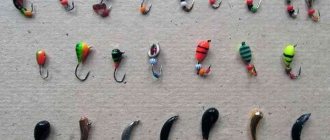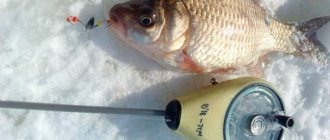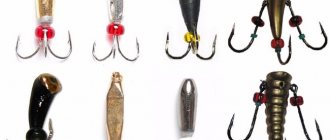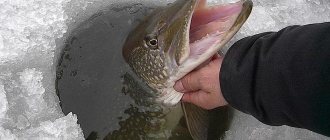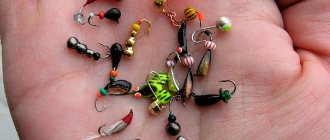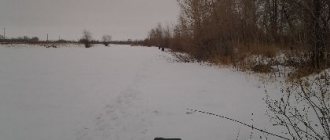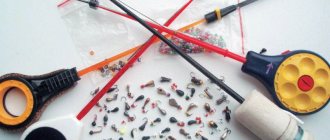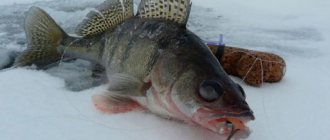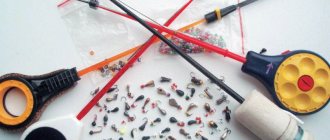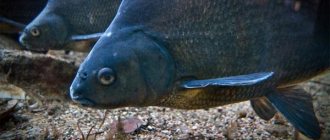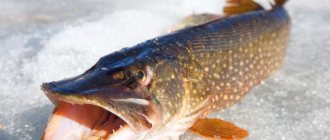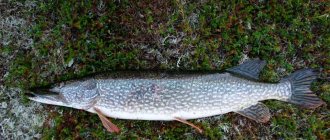Winter jigs for bream are a mandatory attribute of every bream fisherman. Catching bream in winter with a jig is the main way to catch this fish from the ice. This bait is used in different tackles and in different fishing conditions. There are also special requirements for bait and gear that uses it, related to the feeding habits and life activity of bream.
Fishing methods
Methods for winter fishing for bream with a jig:
- Fishing with a fixed jig on a float or a nodding fishing rod.
- For a game with baiting bloodworms (mormyshing).
- Fishing without bait (reelless).
- Use in current gear (garland, steam locomotive, descender, helicopter).
Let's take a closer look at these methods, the features of equipment for winter fishing rods, the baits themselves and aspects of their use.
Recommendations :
1. Having chosen the exact habitat of the fish according to the season, you need to carry out preliminary feeding.
2. It is better to cast over long distances in swimming craft.
3. Use jigs by color. They are different for 4 seasons.
4. Don't be afraid to run your game.
5. Take a large arsenal of gear with you.
6. Use fishing methods using catchable options.
It turns out that each jig has its own real opportunity to please the fishermen. Their principle is simple, but there are differences in color, shape and basic games on different bodies of water.
You can catch bream with this tackle if you have the slightest initial understanding of how to use it. Beginners can achieve results if they understand the essence of the gear. There is nothing complicated.
Understand and understand the principle of bream behavior under water in order to make it react to different types of jigs. Why, knowing all the subtleties and secrets, is it impossible to bring the long-awaited trophy home?
Incorrect assembly, inappropriate place and playing with mistakes, all this leads to downtime on the water. Review your gear, prepare properly, and ask experienced fishermen for advice.
If you want to catch bream, then don't buy a bunch of gear that doesn't work in your area.
Read our presentations several times, then you will really get an idea of real fishing, which is much more interesting in the wild than on paid reservoirs. The difference is huge, you can't argue with that.
We recommend that you read:
Also on this topic:
Bream and bream - what's the difference
Fishing for bream with a ring - equipment and fishing techniques
Read How to ship a fishing float
Catching bream in autumn: all the methods and tips
All gear for bream - for fishing from the shore and from a boat
Catching bream in November using a feeder, donka, fishing rod, the best tips from fishermen
Tactics for catching and feeding in winter
Tactics and bait for winter bream are inseparable. Proper use of bait for bream is one of the most important conditions for successful fishing. The flock must first be found. To do this, in promising places, holes are drilled at a distance of 20-30 meters (no closer) and fed. The composition of winter bream bait and the rules for its use in winter are described in detail in our article:
Each hole is then checked, but for this a whole range of winter gear is used, depending on the preferences of the angler and the fishing conditions. In still water, bait is used with a dump truck and a set of fishing rods:
- Winter float.
- Nodding to the boner.
- Mormyshing with a nozzle.
- Mothless.
All of these tackles use jigs. During the current, it is better to feed through the second hole, located strictly up from the working hole. It contains a mesh feeder, from which the current washes away the food and forms a feeding spot, respectively, in the direction of the flow.
Bream fishing is most successful in winter at night; the largest specimens only go to feeding areas at night. Therefore, you need to arrive at the reservoir in advance in order to have time to find a catchable place and stay there for the night.
Fishing for bream in December using a jig is more active than in the middle of winter. At such times, fish can be found in fairly shallow (2-3 meters) places. At this time, the rewinder shows itself well. Closer to the dead of winter, the bream finally slides into deep holes, and goes out to feed not far from them, on nearby edges, dumps, tables and banks. It is better to catch it in deep winter exclusively at night (if you need a large bream and not a bream) with bait on a riser from the bottom, periodically checking how it reacts to playing with bait. By the end of winter, the fish become active again, and active methods of searching and fishing in fairly wide water areas come into play again. But these are all matters of personal preference. Some winter fishermen prefer a float, others prefer a nod, and others fish exclusively with no bait. The surest option is versatility, using different gear depending on the conditions and preferences of the fish.
How to catch bream in winter using a jig? Let's consider the main gear and the key points of their installation.
Fixed jig as part of a fishing rod rig
The simplest equipment for a winter fishing rod for bream with a jig simply involves one bait at the end of the fishing line, with a float or guard acting as a signaling device. At first glance, everything is simple, but in fact, even such a fishing rod requires fine tuning. This is due to the great depth and sensitivity of this fish to foreign objects in the mouth, which it instantly tries to get rid of as soon as it feels it. We have already discussed this issue in the article about winter fishing rods for bream. There is even a special ultra-sensitive equipment for great depths with two floats. Such a float tackle for catching bream in winter with a jig (or a hook with a sinker) allows not only to determine the bite. During a bite, the float takes part of the weight of the bait upon itself, making it lighter, which allows you not to arouse unnecessary suspicion in cautious fish. The jigs themselves must comply with certain rules.
Requirements for a jig when fishing with a riser
Due to the structure of the bream’s mouth and its feeding habits, any first bait that comes along will not work. When choosing a jig for bream, it is important to consider the following aspects:
- Weight,
- Color,
- Hook,
- Form.
Weight is a requirement not for the taste of the fish, but for the purpose of organically adjusting the gear. The tackle should sink to the bottom normally, and you have to fish at a depth of 10-15 meters. Therefore, a heavy winter jig for bream is needed, but the equipment is adjusted so that when biting the fish does not feel this weight.
According to anglers, in the middle of nowhere, inconspicuous jigs without any frills work better. Black, dark, brown colors are just right. On some reservoirs, baits with a phosphorus eye work well at night. In muddy water, sometimes bright colors show themselves well - acid green, red, white.
For stand-up fishing, baits with a perpendicular suspension (or at least at an angle) to the main line are selected. This is necessary for proper hooking when the fish takes the bait into the tubular mouth. The most catchy jigs for bream in winter:
- An ordinary drop
- A droplet with a ring,
- Uralka,
- Uralka with a ring,
- Cone,
- Cone with a ring,
- Reverse Uralka,
- Reelless baits without decorations, used for fishing with black risers - ants, nymphs, bananas, etc.
The main requirement is a hook. It needs to be somewhat larger than on the most common store-bought baits, and with a long fore-end. The sting is bent away from the fore-end and along the axis for better grip. The hooks themselves, of course, need to be thin, strong and sharp.
Secrets of ice fishing with a reelless bait, jig selection and games
One of the popular types of winter fishing is reelless fishing. It is used by both experienced sports fishermen and ordinary ice fishing enthusiasts. You need to try hard to tempt not only a hungry perch, but also a wary bream with artificial bait. Inattention to any little detail will result in a lack of bite. To return home with a catch, you need to collect sensitive reelless gear, select high-quality jigs and develop several fishing options until it becomes automatic.
Popular rewinders
Not so long ago, one of the main problems for jig fishermen was purchasing high-quality bait. If the game of a baited jig is not so important, because the fish are attracted by the natural bait on the hook, then when fishing without a bait, the behavior of the bait comes first. Therefore, fishermen themselves invented, made and tested catchy reelless jigs. Today, the achievements of craftsmen have been picked up by both local and foreign manufacturers. Now the difficulty for beginner jig fishers is choosing a working bait. Below are the most popular nozzleless jigs.
- One of the oldest non-moths, which was successfully used with bloodworms, is the Uralka. Its characteristic feature is the combination of a single hook and a curved lead body.
- The famous devil jig has a strictly vertical game. It is easy to make; just apply a drop of solder to the small tee, and the bait is ready.
- A drop is considered a universal bait. It allows you to fish with or without bait. The components of the jig are a single hook and a drop-shaped body.
- Goat fishing is considered quite simple in winter fishing. The bait is a modification of the Uralka, only instead of a single hook a double hook is soldered in.
- A perch eye jig has been developed for hunting striped predators. The combination of a single hook and a golden ball with a painted eye has a mesmerizing effect on the perch.
- In an ant jig, the body consists of two balls of different sizes, welded into a single whole with a small hook.
- Many fishermen liked the exclusively Russian bait Balda. Reelless jigs of this type exist in different sizes, shapes and colors. Two hooks remain unchanged, moving freely along the line installation.
- The nymph is a jig with a curved body, which has grooves around its circumference. A single hook is soldered into the body.
- The witch has a lot in common in appearance with the bully. Only three hooks are pressed against the body of the bait, as a result of which their movement is limited. Witch fishing is based on the use of specific wiring.
- The serpentine body has become the hallmark of the cobra jig. A single hook acts as a tongue.
Choosing a nozzle for catching different types of fish
Reelless fishing often becomes fruitless due to the wrong choice of jig for a specific type of fish. If the bait is to the taste of the perch, this does not mean that the bream or roach will pay attention to it. This factor plays a decisive role in winter fishing. Sometimes even the color of a bead can affect the bite of a particular type of fish.
An illustrative example is the fashionable cat's eye jig. Many fishermen are confident that this nozzle catches any fish even in the dead of winter. The characteristic features of the new product are the cylindrical shape of the body, a single hook and a movable ball on the fore-end. Different types of fish prefer certain colors of the ball.
- Roach and ide respond well to the green color of the bead.
- When catching bream in winter with a reelless bait, it is better to equip the jig with a milky-white ball.
- Striped predators prefer yellow or orange cat's eyes.
Assembling a fishing rod
To get an artificial bait to make believable movements in the water, you need to assemble a balanced reelless fishing rod. Experienced fishermen collect gear based on their anthropological data and habits developed over the years.
- Beginners can be advised to purchase a simple balalaika and install a rewinder nod on it.
- It is convenient to use a fishing rod that is equipped with a reel. Then the transition to another depth will occur quickly and comfortably.
- The diameter of the fishing line must correspond to the size of the jig. Using a thick fishing line will spoil the action of the bait, which will negatively affect the number of bites.
- Good gameplay requires sensitive nods for the rewinder. They can be cut out in large quantities from multi-colored plastic. It is advisable to select a suitable guard for each jig by testing their combination at home in a transparent bottle or bucket.
- Some fishermen claim that a reelless fish without a nod can avoid idle bites. In such gear, the role of a bite alarm is played by the fisherman’s finger. Due to the absence of free play (equal to the length of the nod), hooking becomes effective.
Working animation options for mothless creatures
You need to choose your own game for each reelless jig. Experts identify several techniques that can be useful when fishing.
- The Ural jig works best with smooth play. The bait slowly rises without playing along to a height of up to 1 m. At the top point, a stop is made for 2-3 seconds. It is enough to make 3-4 movements for the fish to respond to the animation. A similar technique can be used for a nymph baitless jig.
- The devil's game begins with tapping the bait on the bottom. Then the bait begins to rise with smooth swaying movements of the nod. Having reached eye level, a pause is made for 2-4 seconds. The number of cycles in one well is 3-5 times.
- When catching perch in snags, anglers use a jig called a nailball. The bait rises slowly, and the vibrations of the nod should be high-frequency with low amplitude.
- The roach prefers the mid-frequency play of a goat or devil with a small amplitude. After a meter rise, a pause of 3-5 seconds is maintained.
For such jigs as the witch and the fool, a different fishing technique is used. From the bottom, the bait is thrown 15-20 cm with a wrist movement of the fishing rod. The tip of the tackle immediately lowers to its original position. The pause can last from 5 to 10 s. The perch that most often falls for these reelless baits grabs the bait from the bottom.
Tactical points
When catching many types of fish, the bite may also depend on how correctly the tactics are chosen. In some cases, the mothless machine begins to work only after several important conditions.
- The rod is clearly balanced and the nod is correctly adjusted.
- The fisherman pinpointed the location of the fish.
- The optimal dose of attractive bait is dropped into the hole.
If the fishing rod is carefully assembled and tested at home, then the next task will be to find fish. In winter, fishing spots will be:
- entrances and exits from depth;
- edges and steps;
- stuck water areas;
- windows among aquatic vegetation;
- places where streams and springs flow.
Feeding the holes is done according to the following scheme.
- First, preliminary feeding of all holes, which are made in the amount of 10 pieces, is carried out. at a distance of 5-7 m from each other. To do this, just drop a pinch of bait into the water.
- Each hole is examined for active fish. 4-5 postings will be enough for a preliminary study of the hole. If timid or confident bites were observed, this point should be thoroughly fed. The winter feeder is filled with bait and sent to the bottom.
- In the future, all productive holes are carefully fished. As the bite subsides, a small portion of bait mixture or small bloodworms is dropped into the water.
Fishing with a reelless reel in winter can bring a lot of pleasant emotions. If you take into account all the factors that influence the bite, you won’t have to return home without fish.
Bait fishing with game
The baits described above are used as jigs for bream in winter. One or more bloodworm larvae (less often a worm or maggot) are added to the hook. Fishing is done for the game. Jig tackle requires that the nod and the weight of the jig match. This method is convenient to use when searching, and can also be used together with stationary fishing, next to the holes where fishing rods are installed on a riser.
Bait game
When fishing for bream, a smooth, amplitude game is used. This fish does not like fast and sudden movements of the bait. The bream jig should not plan; the correct movements are swaying and tilting. You should experiment with the wiring option. It is better to conduct experiments in the direction of reducing speed and increasing the smoothness of the bait’s movements. Usually the bite occurs during a pause at the bottom, so any moments of the game alternate with stops:
- Slow tapping on the bottom (several times, then pause).
- Tapping and slowly raising 3-5 centimeters, lowering, pause.
- Smooth movements up and down with an amplitude of 7-10 cm.
- Slow rise with trembling of 15-30 cm, immediately the same slow descent, pause at the bottom.
- Slow smooth descent from half a meter, pause, rise again.
- Gent lifts of 3-5 cm, alternating with a pause when the bait is at the bottom.
Features of choosing a jig for bream for winter fishing
Reservoir depth
To catch bream, you should choose fairly deep places, such as reservoirs. What are they good for? In such reservoirs, the water does not freeze to the bottom, which can often be found in winter on small ponds and lakes. It is also worth saying that bream always stays closer to the bottom, since there is a lot of food for bream at the bottom.
Places with a sharp change in depth will also be preferred; such places will also appeal to this fish. You should not look for bream in small lakes. This fish loves reservoirs where the depth is more than two meters. By choosing the right place for fishing, you can be sure that the catch will not take long to arrive.
Jig color
I must say that this inhabitant has a very capricious disposition. Today he can bite perfectly on one jig, and tomorrow there won’t be a single bite on the same jig. Therefore, when fishing for bream, it is worth acquiring many different models; only with a large arsenal of baits can you achieve a really good result. You can also use a rocker to catch especially large bream in winter.
Many experienced fishermen advise buying banana-shaped jigs. It is believed that bream really likes such options. Most often, bananas are painted in two colors, black and yellow, but there are also other options. But you shouldn’t rely on only one type of bait; it’s better to purchase several more varieties.
Catching models of jigs
An excellent option for catching this fish would be the Tungsten jig model. LJ ANT. It is made in gold color, with a small red cambric at the end. The model can be purchased with a weight of 4.8 grams, or 6.2 grams. These options should only be fished vertically.
Other types of fishing will not be appropriate in this case. Bream responds very well to this model, so you might consider purchasing it.
The tungsten jig also works well. LJ PS BANANA with loop SZH. There are many sizes on sale, which will allow you to choose a jig for specific fishing conditions.
- goat
- devil
- pellet.
Equipment
The equipment for game fishing must be adjusted to match the nod to the weight of the jig. The winter fishing rod for bream with a jig is mounted light and convenient. Store-bought fishing rods (light balalaikas and reel fishing rods), as well as homemade plugs, washers, etc., are suitable. It is more important to adjust the nod - it needs to be long and flexible in order to give the bait the correct smooth play. Under the weight of the bait, the correct guard bends 25% of the circumference. In contrast to the elastic properties of a short nod, which are useful when fishing for perch, a long bream guard is smooth, slightly inhibited. A variety of jigs are used for game fishing. It is impossible to single out one catch option - this is established experimentally on the spot.
When does bream bite?
Bream can grab bait both during the day and at night. At the same time, during the daytime it will peck on various baits, and in the dark - most often on animals (maggots or worms). The most catchable time of the year is the end of spring or the beginning of summer (May, June), immediately after the end of spawning. During this period, the fish are hungry, which ensures frequent, and even aggressive, biting. This representative of the carp family can be considered one of the most timid inhabitants of reservoirs, preferring to stay closer to the center of the river or lake, most often at depth.
But soon, after spawning, schools of bream swim to the shallow water and rummage in the muddy bottom, looking for food. The fish sucks up the bottom mud and, in its mouth, separates it into edible and inedible components. At this time, she is unpretentious in food, and picks up everything that can be found at the bottom. In the summer, when the river warms up well and real warmth sets in, the bream begins to bite sluggishly, unlike in spring, early summer or autumn. This passivity is explained by the breed’s dislike of heat. If in the first month of summer the bite occurs both on plant baits and on animal baits, then closer to mid-July the fish often does not respond to the bait.
Did you know? A well-known fishing joke: a bream is a caught fish, and a bream is one that “got off, you bastard!”
Even knowing the difficulties of fishing at this time, amateurs do not stop hunting for bream, and the result can be quite good, especially if a person chooses the right place. Already in the first days of autumn, the time for active feeding of bream begins and continues until November, when the first ice appears on the reservoirs. After this, the fish find a suitable hole for the winter, where they remain in the suitable company of their relatives until spring.
Jigs
The best jig for bream in winter can only be in the opinion of a particular angler for use in certain fishing conditions. Everywhere there are various tops and ratings of the most catchy jigs for bream, but these are tricks of marketers. You need to collect an arsenal of various options, since you don’t know in advance what will “shoot” today. Large bream will even attack a small balancer or spinner. Some fishermen make jigs for bream with their own hands, since they are not satisfied with what the stores offer. Various kinds of drops, ants, lentils, bugs, diamonds, balls - all this can be useful.
The requirements for bait have already been indicated above. Sometimes in winter even specific baits work, which are often used for catching perch. There is often information that ring jig mounts (semi-offset) work better, but there are also a lot of positive reviews when using standard droplets. Good jigs are those that the angler was able to use competently on a pond, taking into account search, weather, bait, fish behavior and other factors. Therefore, the answer to which jig is better to catch bream in winter is the one that the fisherman was able to skillfully use in these specific conditions of the reservoir and weather.
Mothless
There are no special bream jigs for baitless fishing as such; the fisherman needs to use his entire arsenal to select a working one. Many anglers successfully practice winter fishing for bream using the devil. Even the color of beads and beads on bream jigs affects the bite in winter. It is important to understand that catching bream with a reelless bait is more relevant for the first ice and the last ice. You can find fish at this time in fairly shallow areas without using bait.
Locomotives and garlands
A steam locomotive is a rig consisting of several jigs attached one after another to the main fishing line. Such equipment is used on the working part of a descender or other bottom gear for currents. Some winter anglers also use it for standard vertical fishing with a reelless bait. One of the varieties is a garland. In principle, it’s the same thing, only the baits are attached to the fishing line with leashes. Different baits are used, for example, devil at the end, light phosphorus - above. The options are limited by the angler’s imagination and the preferences of the fish in a particular body of water.
